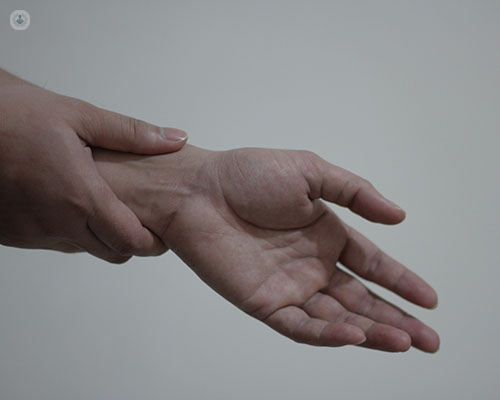


What is rhizarthrosis?
Rhizarthrosis, also known as trapeziometacarpal osteoarthritis, is a type of arthritis that primarily affects the thumb or, more precisely, the trapeziometacarpal joint of the hand. This degenerative disease involves chronic inflammation and it is caused by ageing and by the wearing of the cartilage between the first metacarpal bone and the trapezium bone. This condition primarily affects women.

Prognosis of rhizarthrosis:
The outlook of rhizarthrosis is generally negative, because it is a chronic inflammatory disease that tends to worsen over time.
What are the symptoms of rhizarthrosis?
The main symptom is a persistent pain at the base of the thumb. Other symptoms may include:
- Swelling at the base of the thumb;
- Difficulty in using your thumb (for instance, when opening a jar);
- A sensation of stiffness of the trapeziometacarpal joint;
- An odd sound when moving the affected joint
How is rhizarthrosis diagnosed?
You will need to go through the following with your GP:
- Check which symptoms you have;
- Doing a physical examination, based on the symptoms you have, and doing some specific manoeuvres;
- Look at your medical history and family history;
- X-ray scan
What causes rhizarthrosis?
This condition usually arises with age: the main cause of rhizarthrosis is the wearing of the joint at the base of your thumb. Sometimes it can be a consequence of previous joint fractures.
How can rhizarthrosis be prevented?
To prevent this acute inflammation, you should avoid overloading the hand joints - this can be done by changing, eliminating or reducing some of your daily habits.
How is rhizarthrosis treated?
As of yet, there is no specific treatment for rhizarthrosis. However, you can choose between conservative treatment or surgery, which aims to:
- Reducing the inflammation, the pain and swelling (the pain associated with the inflammation and the swelling);
- Improving your range of motion;
- Allowing you to go on with your normal, daily activities.
Conservative treatment consists of resting your hand, applying ice packs, taking anti-inflammatory medication, using a splint at night and physical therapy sessions to strengthen and elongate your hand’s muscles.
Surgery can either be:
- Arthroplasty: reconstruction of the damaged joint by using a prosthesis;
- Arthrodesis: securing together or fusing together the trapezium bone and the first metacarpal bone;
- Arthroscopy: resection of a portion of the trapezium bone;
- Trapeziectomy with ligament reconstruction: resection of the trapezium bone and ligament reconstruction.
Which doctor should I talk to?
For an accurate diagnosis and treatment of rhizarthrosis, you should see an orthopaedic surgeon.